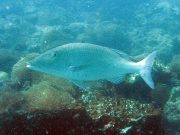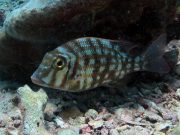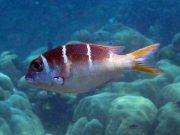Diving with Emperors
Lanta Marine Life | Lethrinidae
Emperors are a family of around 30 different species, sometimes also called emperor breams. Emperors live on or close to coral reefs and are found at all of the Koh Lanta dive sites.
Features common to this family include thick lips, strong jaws, and cheeks without scales.
These bottom-feeding fish eat sea snails, crabs, sea urchins, worms and many other animals that live on the seafloor. Some of the larger species feed on other fish. Some species have molar-like teeth which they use to crunch the shells of their food.
Most species of emperors begin life as females and change sex to become males as they grow.
Large schools of spawning emperors can form around the new or full moon in some months. Females release thousands of eggs which are then fertilised by sperm released by males and will drift in the plankton until hatched and big enough to return to the reef.
4 species found on this page:
Pinkear Emperor
(Lethrinus lentjan)

Lethrinus lentjan @ Koh Haa
The Pink-Ear Emperor has a silvery greyish body, with a whitish belly. May have a reddish or orangish tinge on the upper back, rear dorsal and tail fins.
The scales are large and in a diamond pattern and there is a blood-red streak on the rear edge of the gill cover. The pectoral fin may be pale orange, whitish or yellowish.
The Pink-Ear Emperor grows to 50 cm, but usually observed around 30 cm. Normally a solitary species, they may form small groups
The diet includes crustaceans, snails, echinoderms, bristle-worms, bivalves, and small fish.
Smalltooth Emperor
(Lethrinus microdon)

Lethrinus microdon @ Hin Bida
The Smalltooth Emperor has an elongate body with a long, pointed snout, The body is silvery/bluish grey, sometimes with scattered irregular dark blotches on the sides.
Some individuals may also have three dark streaks radiate from the lower part of the eye toward the tip of the snout / mouth.
The Smalltooth Emperor may camouflage by changing to mottled and blotched shades of brown, but will retain any dark streaks radiating from eye toward tip of snout.
The Smalltooth Emperor grows to 70 cm, but more commonly observed in the 40 cm - 50 cm range. Can be observed solitary or in small schools.
The diet includes fish, crustaceans, cephalopods, and bristle-worms.
Ornate Emperor
(Lethrinus ornatus)

Lethrinus ornatus @ Koh Bida
The Ornate Emperor has a silvery body with broad yellowish-brown horizontal stripes on the sides. Very often there will also be 7 - 8 vertical bands along the body, giving a checkerboard appearance.
There is a red margin on the cheek and gill cover. The dorsal and tail fins are purplish, with the other fins being orange-yellow, often tipped with red.
The Ornate Emperor grows to 40 cm and is usually found in sandy or rubble areas close to the reef edge, either solitary or in pairs.
The diet includes crustaceans, slugs, snails, echinoderms, bristle-worms and small fishes.
Redfin Emperor Bream
(Monotaxis heterodon)

Monotaxis heterodon @ Koh Haa
The redfin emperor bream has a mainly silvery body colour, with a large, dark reddish patch starting above the eyes and running along the back to the end of the dorsal fin.
There are four vertical white stripes which are about the same width as 2 scales. The tail is yellowish/orangish. When the pectoral fin is opened, it reveals a strong dark reddish patch.
This species can grow to 60 cm, but is usually observed much smaller than this, typically 15 - 25 cm.
This species can be confused with the bigeye seabream (Monotaxis grandoculis) which is also a member of the emperor family. The main difference between the two species is the width of the four vertical stripes - in Monotaxis grandoculis the stripes are four scale-widths wide. In Monotaxis grandoculis the dark patch on the back does not extend down toward the middle as much as in this species (Monotaxis heterodon).
Diving with Emperors around Koh Lanta
Scuba Diving & Snorkel Trips
If you'd love a chance to spot Emperors on one of our daily high season diving trips from Koh Lanta then send us an email to info@diveandrelax.com.
Join our high season speedboat dive trips to some of Thailand's best dive sites and enjoy small groups, short journey times, with a focus on great personal service, safety and fun.
Not yet a certified diver? Learn to Scuba Dive on Koh Lanta with the 3 day SSI Open Water Diver course.
Book online to save 10% on dive trips and scuba courses on Koh Lanta.
Find Out More
Indo-Pacific Marine Life Guides
- Allen, G., Steene, R., Humann, P., DeLoach, N. (2003) Reef Fish Identification, Tropical Pacific. Jacksonville, FL., USA: New World Publications, Inc., ISBN 1-878348-36-1.
- Humann, P., DeLoach, N., (2010) Reef Creature Identification, Tropical Pacific. Jacksonville, FL., USA: New World Publications Inc., ISBN 978-1-878348-44-9
- Debelius, H. (2013) Indian Ocean Reef Guide. Frankfurt, Germany: IKAN - Unterwasserarchiv, ISBN 978-3-939767-52-7.
- Debelius, H. (2004) Nudibranchs and Sea Snails, Indo-Pacific Field Guide. Frankfurt, Germany: IKAN - Unterwasserarchiv, ISBN 3-925919-51-1
- Erhardt, H., Knop, D. (2015) Corals Indo-Pacific Field Guide. Frankfurt, Germany: IKAN - Unterwasserarchiv, ISBN 3-925919-69-4.
- Veron J.E.N., Stafford-Smith M.G., Turak E. and DeVantier L.M. (2016). Corals of the World
